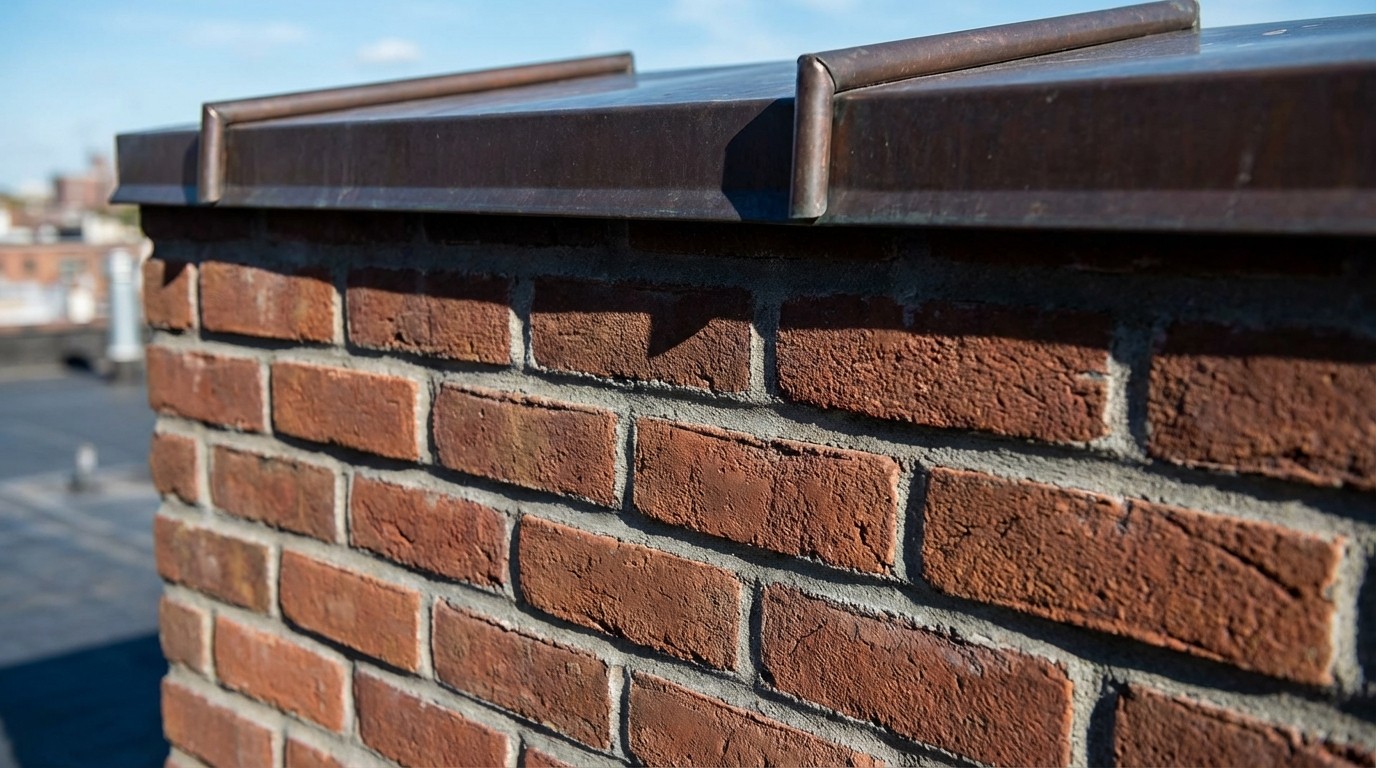Soffits are often overlooked components that homeowners don't think about until damage occurs.
This guide covers what soffits do, the different materials available, signs of damage to watch for, and how installation works from start to finish.
What Is a Soffit
Soffits are essential components that protect your roof structure while providing necessary attic ventilation.
Most homeowners overlook their soffits until damage occurs. However, these horizontal panels serve critical functions in protecting your roof structure, preventing pest entry, and maintaining proper attic ventilation.
Where Is the Soffit on a House
Step outside and look up at the edge of your roof where it extends past the wall. That flat panel running underneath the overhang, between your exterior wall and the vertical board at the roof's edge, is your soffit.
The soffit faces the ground. It runs along every side of your home where the roof extends beyond the walls. While the word "soffit" can also describe interior dropped ceilings above kitchen cabinets, this guide focuses entirely on exterior house soffits.
You can identify your soffits by looking at the horizontal panels beneath your roof's overhang on all sides of your home.
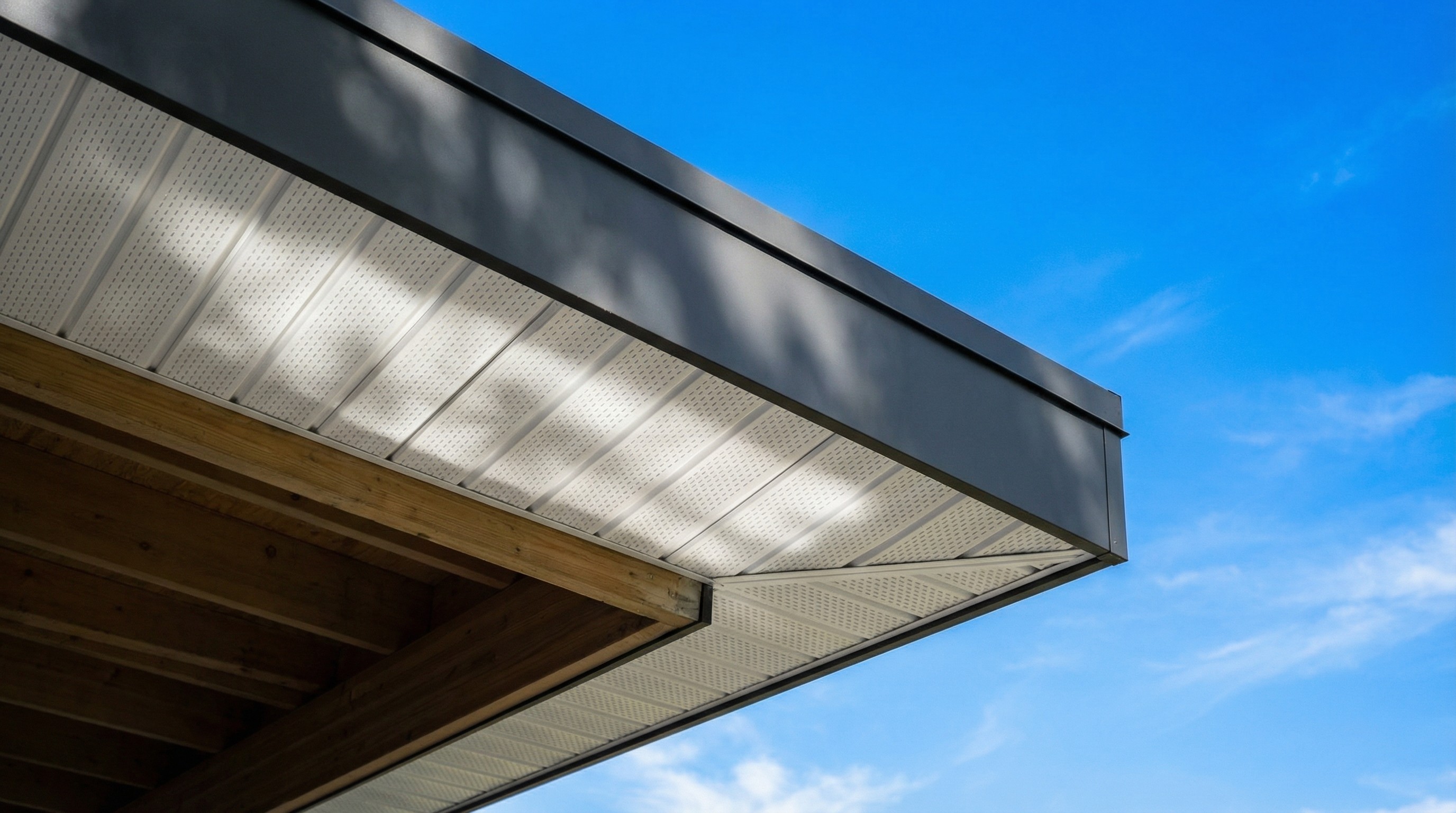
What Does a Soffit Do
Soffits handle four jobs at once. They ventilate your attic, protect your roof from weather, block pests from entering, and give your roofline a finished appearance. Let's break down each one.
Provides attic ventilation
Vented soffit panels have small holes or perforations that let cool outside air flow into your attic. This incoming air pushes hot, humid air upward and out through vents near the roof peak. Without this airflow, heat and moisture build up in the attic, which can shorten the life of your shingles and encourage mold growth.
Cool air enters: Fresh air comes in through the soffit vents
Hot air exits: Warm, moist air rises and escapes through roof vents
Balance matters: Both intake and exhaust vents work together to keep the attic healthy
Protects against weather damage
Rain and snow can cause serious damage if they reach the wooden parts of your roof structure. Soffits cover the underside of the overhang and keep moisture away from the rafters and roof decking. Over time, unprotected wood can rot, and that rot spreads.
Keeps pests out
The gap at your eaves is an open door for birds, squirrels, wasps, and rodents. Soffits close that gap. When soffits crack, warp, or develop holes, animals find their way in and set up nests in your attic. Keeping soffits in good condition is one of the simplest ways to avoid pest problems.
Improves curb appeal
Exposed rafters look unfinished. Soffits cover them and give your roofline a clean, polished look that matches the rest of your home. Most homeowners choose soffit colors that coordinate with their trim or siding.
What Is the Difference Between Soffit and Fascia
Soffit and fascia are two separate parts that work together to enclose your roof overhang. They sit in different positions and serve different purposes.
Soffit: The horizontal panel under the eaves, facing the ground
Fascia: The vertical board at the roof's edge, facing outward, where gutters attach
The fascia forms the vertical edge of your roofline where gutters attach, while the soffit creates the horizontal surface underneath the overhang.
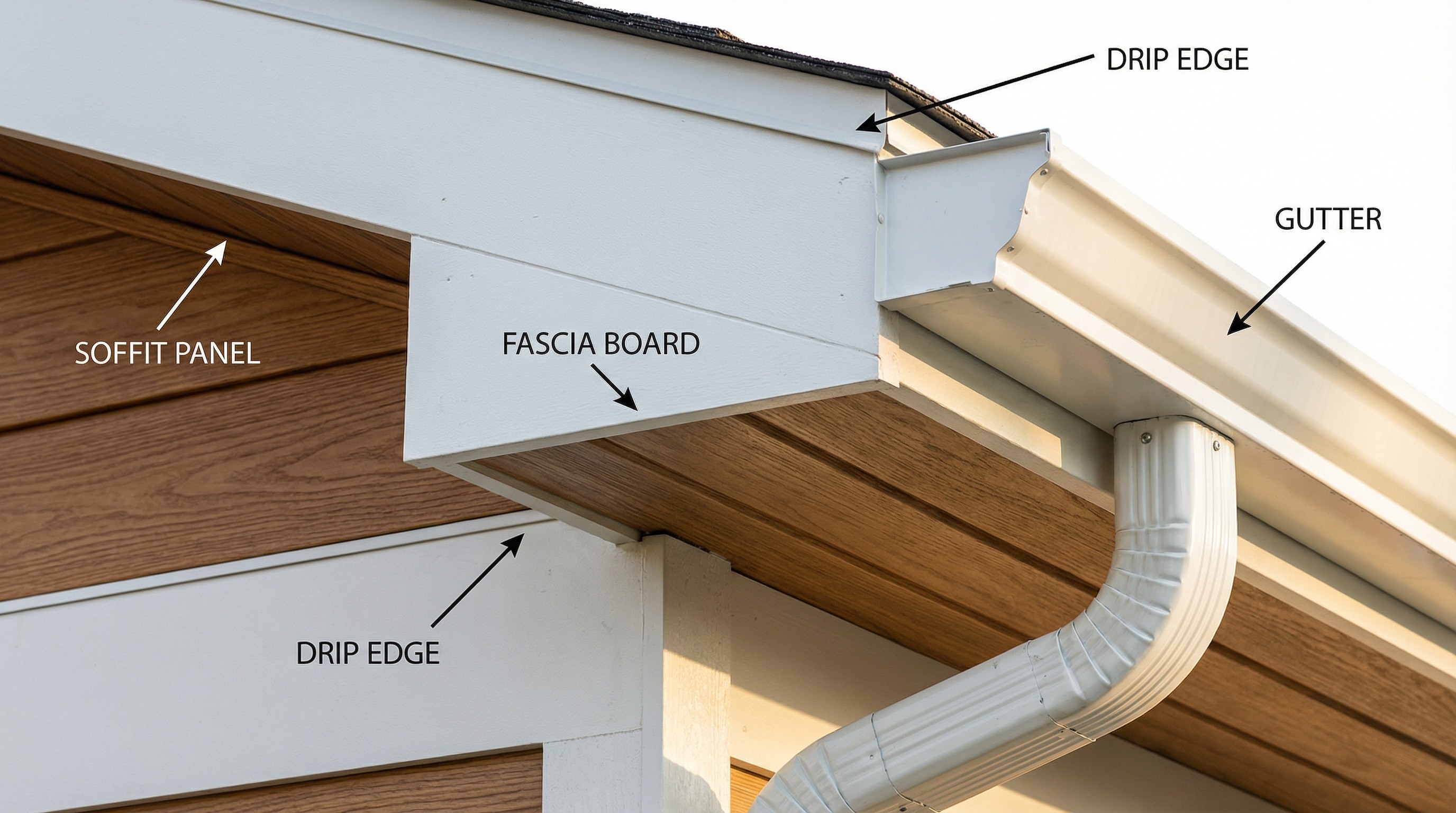
Soffit and Trim Components
Installing soffits requires a few accessory pieces to hold the panels in place and create a finished look. Here are the most common trim and soffit components:
J-channel: A track that holds the soffit panel edges against the wall and fascia
F-channel: An alternative to J-channel, often used where the soffit meets the wall
H-channel: Connects two soffit panels end-to-end when a single panel is not long enough
Inside and outside corners: Finished pieces that cover corners where soffits meet at angles
Your contractor will select the right pieces based on your home's layout and the material you choose.
Types of Soffit Panel Materials
The material you pick affects how long your soffits last, how much maintenance they require, and how they look. Four options cover most residential projects.
Vinyl soffit panels
Vinyl is the most common choice. It costs less than other materials, resists rot and rust, and requires almost no maintenance. Vinyl comes in vented and solid styles across a wide range of colors. However, vinyl can crack in extreme cold temperatures and may fade after prolonged sun exposure.
Aluminum soffit panels
Aluminum works well in humid climates because it does not rust. It is lightweight and holds up for decades with minimal care. However, aluminum can dent if struck by a ladder or debris, and dents are difficult to repair without replacing the panel.
Wood soffit panels
Wood offers a traditional appearance and can be painted or stained to match your home. The downside is maintenance. Wood requires regular sealing and painting to prevent rot, especially in wet climates. In dry regions, wood soffits can last a long time with proper care.
Fiber cement soffit panels
Fiber cement is extremely durable and resists rot, insects, and fire. It delivers a wood-like appearance without the high maintenance. The tradeoff is weight. Fiber cement panels are heavier than vinyl or aluminum, which can affect installation time and cost.
Material | Maintenance | Durability | Best For |
|---|---|---|---|
Vinyl | Low | Good | Budget-friendly projects |
Aluminum | Low | Very good | Humid climates |
Wood | High | Moderate | Traditional aesthetics |
Fiber cement | Low | Excellent | Long-term durability |
Vented vs Non-Vented Soffit Panels
Vented soffit panels have small perforations that allow air to pass through. Non-vented panels, also called solid panels, have no holes.
Most homes benefit from vented soffits because attic ventilation depends on air entering through the eaves. Solid panels are typically used in areas where ventilation is not needed, like porch ceilings or covered patios.
Before choosing, it helps to understand your attic's current ventilation setup. If your home already has other intake vents, you may not need vented soffits everywhere. A roofer can assess what your home requires.
Standard Soffit Panel Sizes
Soffit panels typically come in widths ranging from 12 to 16 inches. Standard lengths run around 12 feet, though contractors cut panels to fit each home's specific overhang depth.
The width of your overhang determines how wide your soffit panels will be. Homes with deeper overhangs may require wider panels or multiple rows of narrower panels installed side by side.
Signs Your House Soffit Needs Replacement
Damaged soffits can lead to bigger problems if left alone. Here are the warning signs worth watching for.
Visible rot or water stains
Dark spots, soft areas, or crumbling material indicate moisture infiltration. Without prompt attention, this moisture damage can spread to your rafters and roof decking, leading to costly structural repairs.
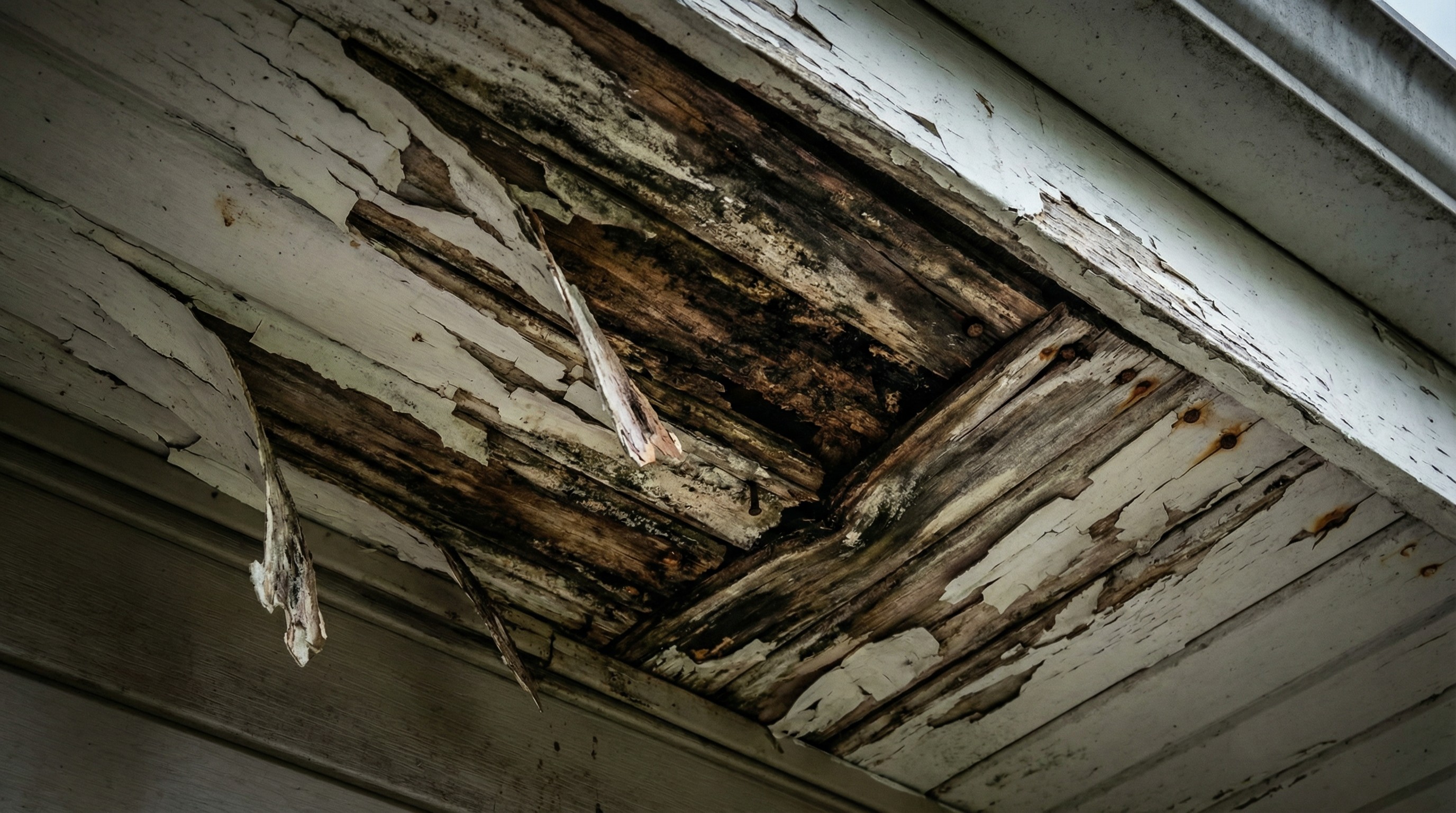
Cracking or peeling paint
Paint that is cracking or peeling often signals moisture behind the soffit. It can also simply mean the soffits are aging. Either way, peeling paint is worth investigating before the damage gets worse.
Holes or pest damage
Small holes may mean insects have chewed through. Larger holes suggest birds, squirrels, or other animals have found a way in. Any hole is an entry point for pests and water.
Sagging or warped panels
Panels that bow downward or pull away from the house point to structural issues or failed fasteners. Sagging soffits often indicate water damage to the wood behind them.
How Much Does Soffit Replacement Cost
The total price for soffit replacement depends on your home's size, the material you choose, and whether any repairs are needed behind the panels.
Material costs by type
Vinyl typically costs $3-6 per linear foot, aluminum runs $4-8 per linear foot, while wood and fiber cement range from $6-12 per linear foot. Getting quotes from local contractors gives you the most accurate picture for your area.
Labor costs
Labor typically accounts for 60-70% of your total project cost, or about $8-15 per linear foot depending on your home's complexity.
What affects your total price
Several factors influence the final number:
Home size: More linear feet of soffit means higher material and labor costs
Accessibility: Second-story soffits or steep roof pitches require more time and equipment
Repairs needed: Damaged rafters or fascia boards add to the project scope
Material choice: Premium materials like fiber cement cost more than vinyl
Comparing detailed, line-item quotes from vetted contractors helps you understand fair pricing and avoid overpaying for soffit work in your area.
How Soffit Panel Installation Works
Soffit installation follows a straightforward sequence. Here is what the process typically looks like.
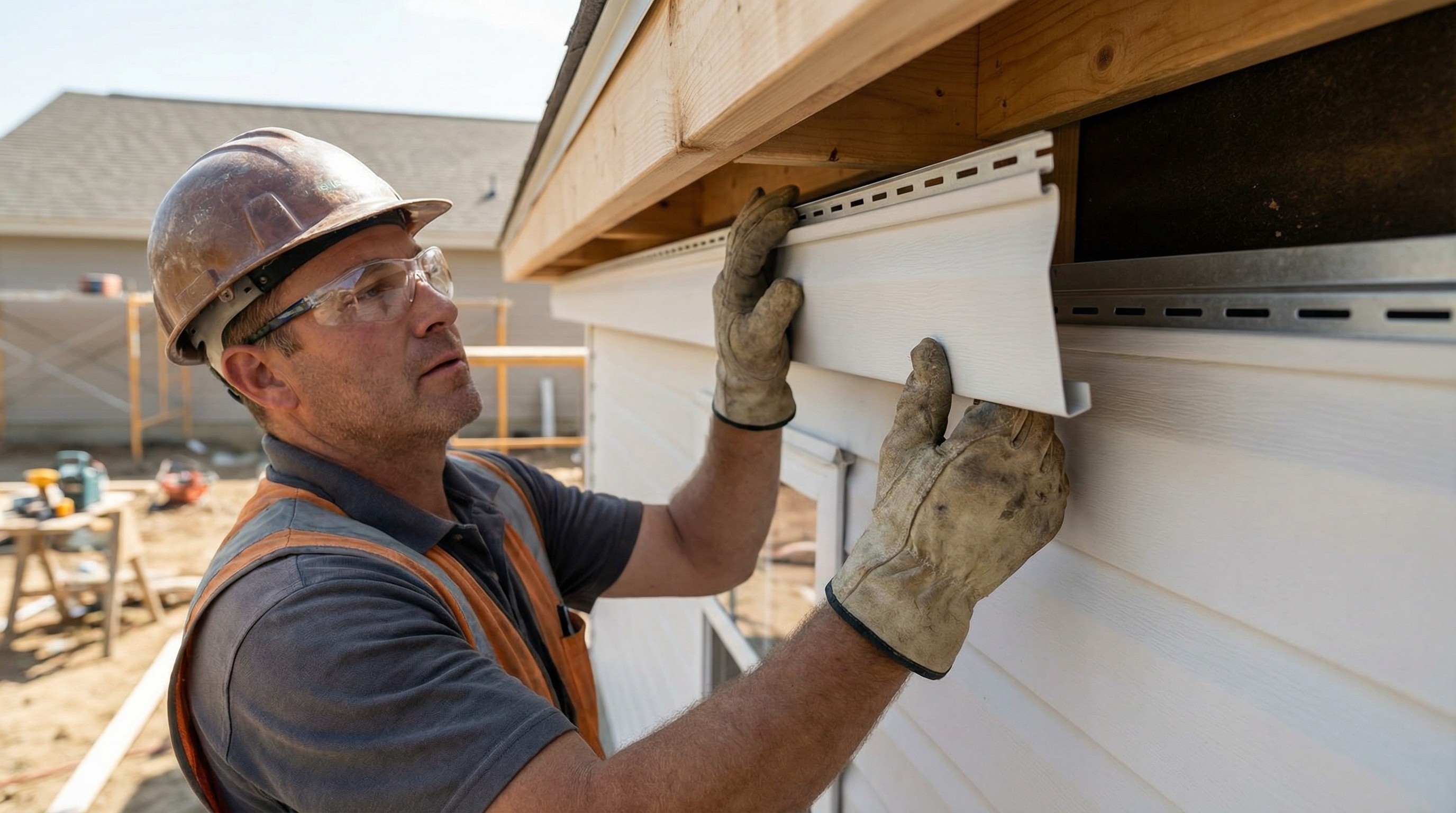
Step 1. Remove the old soffit
The contractor takes down existing panels and trim pieces. This step also involves inspecting the area behind the soffits for hidden damage.
Step 2. Inspect and repair the underlying structure
With the old soffits removed, the contractor checks the rafters and fascia for rot or damage. Any necessary repairs happen before new panels go up. Skipping this step can mean installing new soffits over compromised wood.
Step 3. Install new soffit panels
Panels are measured, cut to fit, and secured into the channels. Vented panels are placed in locations that support proper attic airflow. The contractor works section by section around the home.
Step 4. Add trim and finishing touches
J-channels, corners, and other trim pieces are installed to create clean edges and a finished appearance. This final step ties everything together visually.
Do Pests Like Yellow Jackets Nest in Soffits
Yes. Gaps, cracks, or holes in soffits give wasps, bees, birds, and other pests access to the space behind the eaves or inside the attic. Yellow jackets in particular are drawn to sheltered spots near rooflines.
If you notice insects flying in and out near your soffits, inspect the panels for damage. Addressing gaps early prevents larger infestations and the expense of pest removal.




